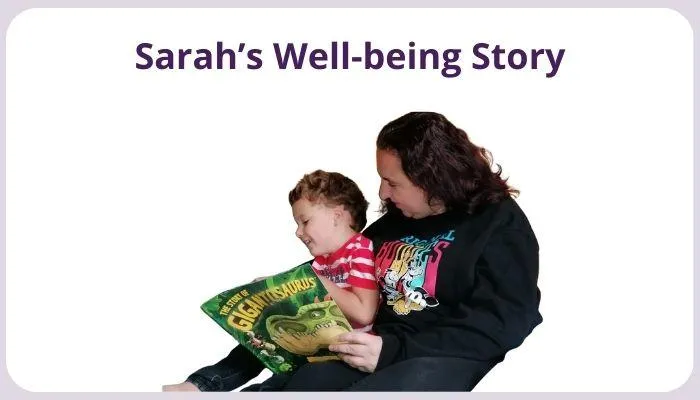Every child's well-being matters.
Safeguarding Case Stories from On the Button

Sarah's Well-being Story
When I returned to work part-time after having my first child, I worked two days a week, job-sharing with an experienced practitioner. We had a strong professional relationship and shared the same mindset: the children's needs always came first. Together, we worked in the funded children's room.
In our group, we cared for children with diverse needs. Some displayed challenging behaviours, others were very shy, and a few attended inconsistently—sometimes showing up one day and then missing weeks.
One child in particular stood out to me, and I want to share how we helped improve her situation, even temporarily. For privacy, I'll call her B.
B had been in the baby room before transitioning to our room, so we had some background information about her.
However, progress with her and her parent had been limited. One of the first issues we noticed was her irregular attendance. She often missed scheduled sessions, which we promptly reported to the office. The office attempted to follow up with phone calls, but they were only sometimes successful. We kept a record of these absences in the register and our staff communication book to ensure consistency in tracking her attendance.
When B did attend, she typically arrived mid-morning and left around 3 or 4 p.m., meaning she was only present for lunch and nap time. She would arrive visibly upset and remained unsettled, seeking comfort exclusively from one or two members of staff.
In our communication book, we documented her behaviour and emotional state, looking for patterns to help us develop a plan to support her and her family. Additionally, we logged her well-being scores using our centre's software, which became the foundation for her care plan.
Although we regularly spoke to B's parent, these conversations were often brief and rushed. To support the family more effectively, we began implementing small but intentional steps.
Our first approach was to have something familiar and enjoyable ready for B when she arrived—an activity or toy she liked—to create a positive association and help her feel connected to her mum as she transitioned into the setting. Both my colleague and I worked on this, and over time, B began settling more quickly. As she grew more comfortable, she started exploring independently and interacting with others.
We adapted our plan to focus on building her social and language skills. Our relationship with B's mum gradually improved, allowing for more open communication. During our discussions, we learned that the family faced challenges with B's brother, which added complexity to their situation.
By using well-being signals, documentation, and our professional experience, we collaborated to support B and her family. While a small step forward, it highlighted the importance of consistent communication and individualised care in fostering a child's well-being.
Sarah is an early years practitioner and consultant with over 20 years of experience working with babies and children.
AUTHOR:- Sarah is an early years senior practitioner with over 25 years of experience in early years education, supporting children, families, and staff across various age groups. She has led an outstanding Ofsted inspection and implemented rigorous safeguarding procedures. A passionate advocate for child safety in sport, Sarah champions safeguarding practices in grassroots football and brings her lived experience as a parent of two. She is part of the team at On the Button, delivering Well-being, Safeguarding and Complaint Management Software to early years settings across the UK.
At On the Button, we support early years settings with powerful tools to strengthen EYFS safeguarding, promote early years well-being, and streamline EYFS complaint management. Our software is designed by sector professionals who understand the pressures and responsibilities of working with children. Whether you're leading a nursery team or supporting children one-to-one, On the Button helps ensure no sign of concern goes unnoticed.

Sarah's Well-being Story
When I returned to work part-time after having my first child, I worked two days a week, job-sharing with an experienced practitioner. We had a strong professional relationship and shared the same mindset: the children's needs always came first. Together, we worked in the funded children's room.
In our group, we cared for children with diverse needs. Some displayed challenging behaviours, others were very shy, and a few attended inconsistently—sometimes showing up one day and then missing weeks.
One child in particular stood out to me, and I want to share how we helped improve her situation, even temporarily. For privacy, I'll call her B.
B had been in the baby room before transitioning to our room, so we had some background information about her.
However, progress with her and her parent had been limited. One of the first issues we noticed was her irregular attendance. She often missed scheduled sessions, which we promptly reported to the office. The office attempted to follow up with phone calls, but they were only sometimes successful. We kept a record of these absences in the register and our staff communication book to ensure consistency in tracking her attendance.
When B did attend, she typically arrived mid-morning and left around 3 or 4 p.m., meaning she was only present for lunch and nap time. She would arrive visibly upset and remained unsettled, seeking comfort exclusively from one or two members of staff.
In our communication book, we documented her behaviour and emotional state, looking for patterns to help us develop a plan to support her and her family. Additionally, we logged her well-being scores using our centre's software, which became the foundation for her care plan.
Although we regularly spoke to B's parent, these conversations were often brief and rushed. To support the family more effectively, we began implementing small but intentional steps.
Our first approach was to have something familiar and enjoyable ready for B when she arrived—an activity or toy she liked—to create a positive association and help her feel connected to her mum as she transitioned into the setting. Both my colleague and I worked on this, and over time, B began settling more quickly. As she grew more comfortable, she started exploring independently and interacting with others.
We adapted our plan to focus on building her social and language skills. Our relationship with B's mum gradually improved, allowing for more open communication. During our discussions, we learned that the family faced challenges with B's brother, which added complexity to their situation.
By using well-being signals, documentation, and our professional experience, we collaborated to support B and her family. While a small step forward, it highlighted the importance of consistent communication and individualised care in fostering a child's well-being.
Sarah is an early years practitioner and consultant with over 20 years of experience working with babies and children.
AUTHOR:- Sarah is an early years senior practitioner with over 25 years of experience in early years education, supporting children, families, and staff across various age groups. She has led an outstanding Ofsted inspection and implemented rigorous safeguarding procedures. A passionate advocate for child safety in sport, Sarah champions safeguarding practices in grassroots football and brings her lived experience as a parent of two. She is part of the team at On the Button, delivering Well-being, Safeguarding and Complaint Management Software to early years settings across the UK.
At On the Button, we support early years settings with powerful tools to strengthen EYFS safeguarding, promote early years well-being, and streamline EYFS complaint management. Our software is designed by sector professionals who understand the pressures and responsibilities of working with children. Whether you're leading a nursery team or supporting children one-to-one, On the Button helps ensure no sign of concern goes unnoticed.

Sarah's Well-being Story
When I returned to work part-time after having my first child, I worked two days a week, job-sharing with an experienced practitioner. We had a strong professional relationship and shared the same mindset: the children's needs always came first. Together, we worked in the funded children's room.
In our group, we cared for children with diverse needs. Some displayed challenging behaviours, others were very shy, and a few attended inconsistently—sometimes showing up one day and then missing weeks.
One child in particular stood out to me, and I want to share how we helped improve her situation, even temporarily. For privacy, I'll call her B.
B had been in the baby room before transitioning to our room, so we had some background information about her.
However, progress with her and her parent had been limited. One of the first issues we noticed was her irregular attendance. She often missed scheduled sessions, which we promptly reported to the office. The office attempted to follow up with phone calls, but they were only sometimes successful. We kept a record of these absences in the register and our staff communication book to ensure consistency in tracking her attendance.
When B did attend, she typically arrived mid-morning and left around 3 or 4 p.m., meaning she was only present for lunch and nap time. She would arrive visibly upset and remained unsettled, seeking comfort exclusively from one or two members of staff.
In our communication book, we documented her behaviour and emotional state, looking for patterns to help us develop a plan to support her and her family. Additionally, we logged her well-being scores using our centre's software, which became the foundation for her care plan.
Although we regularly spoke to B's parent, these conversations were often brief and rushed. To support the family more effectively, we began implementing small but intentional steps.
Our first approach was to have something familiar and enjoyable ready for B when she arrived—an activity or toy she liked—to create a positive association and help her feel connected to her mum as she transitioned into the setting. Both my colleague and I worked on this, and over time, B began settling more quickly. As she grew more comfortable, she started exploring independently and interacting with others.
We adapted our plan to focus on building her social and language skills. Our relationship with B's mum gradually improved, allowing for more open communication. During our discussions, we learned that the family faced challenges with B's brother, which added complexity to their situation.
By using well-being signals, documentation, and our professional experience, we collaborated to support B and her family. While a small step forward, it highlighted the importance of consistent communication and individualised care in fostering a child's well-being.
Sarah is an early years practitioner and consultant with over 20 years of experience working with babies and children.
AUTHOR:- Sarah is an early years senior practitioner with over 25 years of experience in early years education, supporting children, families, and staff across various age groups. She has led an outstanding Ofsted inspection and implemented rigorous safeguarding procedures. A passionate advocate for child safety in sport, Sarah champions safeguarding practices in grassroots football and brings her lived experience as a parent of two. She is part of the team at On the Button, delivering Well-being, Safeguarding and Complaint Management Software to early years settings across the UK.
At On the Button, we support early years settings with powerful tools to strengthen EYFS safeguarding, promote early years well-being, and streamline EYFS complaint management. Our software is designed by sector professionals who understand the pressures and responsibilities of working with children. Whether you're leading a nursery team or supporting children one-to-one, On the Button helps ensure no sign of concern goes unnoticed.
Quality Early Years Ltd.,
Dickens House,
Guithavon Street,
Witham, Essex,
England, CM8 1BJ
© Quality Early Years Ltd 2025
On the Button are Finalists for 3/3 Early Years Awards!
Find On the Button
on Social Media

